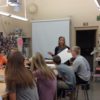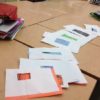Abstract Paintings
Developed by Lindsey Sav
Springboro High School, Springboro
Visual Arts
Grade Levels: 10-12
Introduction
Getting students to let go of predetermined, hard and fast rules can be as difficult as teaching them to follow them was in the first place! Art teacher Lindsay Sav from Springboro High School takes on that challenge with this step-by-step art history lesson plan. She uses her Muse Machine Advanced Teacher Training Seminar experiences in 2016, where she studied the work of Jose Parlá and Jackson Pollock, to inspire her lesson about non-representational art. Experiences with the work of Parlá and Pollock while at the seminar inspired her to take this art form to her students. Pollock was an influential American painter, and the leading force behind the abstract expressionist movement. He developed one of the most radical abstract styles of detaching line from color, redefining the categories of drawing and painting, and finding new means to describe pictorial space. Parlá takes that non-representational art form even further with his moving work entitled, “One: Union of the Senses” which can be seen in the entry of One World Trade Center in New York City. This lesson demonstrates how a good teacher can take an awe inspiring experience at an educational institute and apply it beautifully to her instructional process!





Non-Arts Discipline
History
Content Statement
Enduring Understandings:
The students will gain knowledge about famous artists (Jose Parla and Jackson Pollock), discuss Action Painting, and create non-representational works of art using a variety of art media.
Level of Inquiry: (confirmation/structured/guided/open)
GUIDED INQUIRY
Students don’t know what to do when they don’t know what to do! What’s the difference between thoughtful and thoughtless art? Is the process and the product always equally important? Can the action of drawing be the art? When doodling can there be wrong results?
OPEN/TRUE INQUIRY
Students will reflect on the process and results. They will evaluate strengths and weakness of the results they collect themselves and decide their value. (rubric attached)
Arts Discipline
Visual Arts
Content Statement
Enduring Understandings
How can the process of doodling turn into a more refined work of art? Can expression be conveyed through non-representational art? Can there be wrong results? The students will gain an understanding of how the action of art making can be just as valuable as the product. They will combine the unstructured, open outcome process of doodling with a more developed technique of magnifying part of the doodle and creating a dynamic painting from the particular section.
Progress Points
A visiting artist, graphic designer, will share his doodles with the class and discuss how his drawings became more developed ideas. We will watch a short video about Expressionism and Abstraction (Modern Art, 20th Century Trends, Wilton Art Programs, DVD). Students will listen to music and doodle. Using magnifying glasses, they will look at their paper to find the most interesting composition. Once an area of particular interest is found, the student will create a viewfinder to aid in focusing on that area. Students will then create enlarged paintings of that area.
Strand/Process
Painting
Essential Questions
- How did drawing without guidelines or requirements make you feel?
- Did you ever want to stop and start over?
- What’s the difference between making continuous line drawings versus drawing from life or objectively?
- Was the process and product equally important to you?
- Does your doodling have any personal connections?
- If so, what might they be?
- Can you describe?
Content Elaborations
Students will learn …
About line variation, color, rhythm, emphasis, movement, subjective vs. objective art forms, famous artists Jackson Pollock and Jose Parla.
Expectations for Learning
Students will demonstrate this learning by…
Students will demonstrate this learning through free drawing or doodling which will then become developed paintings with compositions that include the discussed elements and principles of design.
Instructional Strategies
Students will be engaged while listening to a graphic designer (visitor) and will discuss how doodling can assist with creating ideas. Students will also be exposed to Pollock and Parla’s work. The process will begin with very few limitations and a variety of media available to begin doodling to various forms of music. We will discuss what makes a dynamic composition, artistic rhythm, pattern, and visual movement. Students will take these concepts into consideration when magnifying an area of their doodle work. The process begins with space for free expression and little restriction. Each step a new principle and requirement will slowly be added until the final work of art is completed.
Assessment (Pre and/or Post)
Students will know how well they are learning … self-reflection throughout the process, success with implementation of elements and principles of design in final composition, analyzing the transfer of the small area magnified with similarity to the enlarged painting, self-critique through writing about weaknesses and strengths through the entire process, rubric for final painting
Materials & Resources
Materials list for Teachers:
- Modern Art 20th Century Trends by Wilton Art Programs DVD
- access to music mix of songs
Materials list for Students:
- Markers
- Micron pens
- Colored pencils
- 12X18 colored paper
- 12×18 white tag board
- Acrylic paints
- Brushes
- Palettes
Key Vocabulary
- Representational vs. non-representational art
- Non-objective
- Abstraction
- Expressionism
- Doodle
- Action painting (the art movement)
- Process vs. product
- Rhythm
- Visual movement
- Composition
- Line
- Acrylic paint
Student Performance Tasks
- Teacher will show DVD on Modern Art and invite a graphic designer to talk to the class.
- Students will draw while listening to music. They will try continuous line drawings and changing rhythm and direction.
- Students will make a viewfinder to assist in finding the section with the most dynamic composition.
- Students will sketch onto a larger, thicker piece of paper what appears in the viewfinder.
- Students will create a magnified painting of the doodle section chosen.
Career Connections
- Art historian
- Muralist
- Graphic Design
- Studio artist
Diverse Learners
- This project allows different learners and students with different artistic skill levels to feel connected to their work since it’s something they developed from the beginning to the end of the process.
- One on one instruction as needed.
- Modification as needed.
Interdisciplinary Connections
How can the lesson be integrated with activities during ATTS 2016 to strengthen student learning?
Many ideas come from doodling, sketches, lists, and activities that stimulate creative, visual thinking. Doodling, and non-objective art especially allow people to idle with their thoughts and focus on the process of mark making versus so much concentration on the final product.
After visiting the 9/11 mural, Bushwick graffiti, the MoMA, and the Metropolitan Museum of Art during ATTS, I was inspired to create a project centered around non-representational art.
Jose Parla’s One World Trade Center mural particularly resonated with me. The layers of colors and lines on such an expansive canvas were mesmerizing. I wanted to know and learn more about his reasoning for choosing this process After spending time with Jose Parla’s mural and Jackson Pollock’s at the MoMA, I became inspired to incorporate a less structured, more abstract expressive project that allowed the student to creatively think through free drawing time and non-representational painting.
Technology Connections
PowerPoint presentation will be used to show non-representational, representational, and action painting examples.
Possible extension: Students scan final doodle designs into a drawing program on the computer and turn it into a digital drawing using different textures and creating a background.
Ie: Google doodles
Home/At Work Connections
Students will sketch their names as their weekly homework assignment. The name must be written using one continuous line and can have designs around the name. 10 minutes minimum effort.
One: Union of the Senses – One World Trade Center

Visitors are greeted by a huge, 90-foot mural (pictured) that may be the largest of its kind in New York. It is the work of José Parlá, a Brooklyn-based artist who has painted murals at the Brooklyn Academy of Music and Barclays Center. Mr. Parlá worked on it for about eight months in his studio and then for two weeks on site. He wants the colorful, jewel-toned piece, which is covered in his signature, graffiti-esque script and titled “ONE: Union of the Senses”, to stand as a symbol of diversity. “It was very important to me that this painting would reflect a massive respect to the situation and event and the families, and a massive respect for the site,” he said.
Abstract Expressionaism

Jackson Pollock at work using his style which many called, “drip and sling” or action painting. He is often called an abstract impressionist painter.
Action painting, sometimes called “gestural abstraction”, is a style of painting in which paint is spontaneously dribbled, splashed or smeared onto the canvas, rather than being carefully applied.
“Abstract Expressionism” is a vague term which refers to a general movement of largely non-representative painting, which flourished in the United States during the 1940s and 1950s. Spearheaded by a generation of American artists – strongly influenced by European expatriates – who had grown up during the Depression and were influenced both by World War II and its Cold War aftermath, abstract impressionist painting was neither wholly abstract nor expressionist and encompassed several quite different styles. Even so, the diverse exponents of Abstract Expressionism had several aims in common, not least a desire to redefine the nature of painting and in the process create a new type of art.




